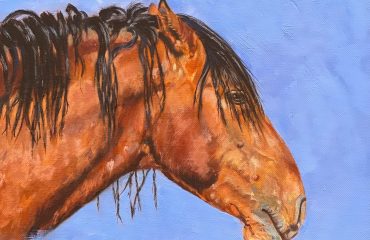By Katie Navarra
Aboard a wooden rocking horse stabled in the waiting room of his father’s pediatrician office, Martin David Cohen spent hours with his “first horse.” Alternating between the rocking horse and a smaller rocking donkey, Martin tallied hours in the saddle. “I rode, or rocked, until they were almost off the ground,” he reminisced.
He graduated to riding lessons when he was 10 years old, learning to ride at Mrs. Burbank’s Riding Academy near the fairgrounds in Memphis, Tennessee. It wasn’t until his early 20s that he owned a horse of his own, but he wasted no time making a name for himself as a professional horseman and FEI/USEF judge, course designer and chief steward. In 1984 and 1996 he was invited to judge multiple equestrian events at the Summer Olympic Games in Los Angeles and Atlanta.
Despite success as a professional horseman, one thing always perplexed him: He couldn’t understand why the natural position of English stirrups was to lay flat against the horse’s side and move away from the needed riding position. Puzzled, he asked riders, trainers and judges what benefits this position offered the rider.
Not one person could identify any advantage.
Aside from being illogical, he knew the traditional design posed a safety hazard. “When a rider’s foot falls out of the stirrup, a traditional stirrup aggressively turns back to side of the horse and that’s the number one reason people get hung up and dragged,” Martin explained. He calls this the “closing door effect.” Due to the stirrups turning back to the horse, stirrup retrieval is more difficult. “So why is this design flaw still in our industry?” he asked.
Being a fan of Western riding too, Martin realized that “cowboys” already knew the benefits of forward-facing stirrups. “The cowboys figured out a long time ago that stirrups should face the front of the horse,” he commented. “The first thing a cowboy does to his Western saddle is turn the stirrups to the front.” Knowing English stirrup leathers were too thin to allow for this forward-facing benefit, he began searching for a solution in the stirrup itself.
For several years, the idea of developing a more functional and safer stirrup permeated his thoughts. While sharing his idea with an engineering friend, he decided to develop a prototype. Without any experience in metallurgy, product design or distribution, Martin worked closely with a series of engineers and patent attorneys to develop the first American-designed English stirrup that would maintain a 45° or 90° degree forward-facing angle. In 2003, he released his first patented design, the MDC Ultimate Stirrups™ and MDC Comfort Stirrup™.
His patented designs allow riders of all riding disciplines to find the position that provides the best support and comfort for both themselves and their horses’ conformation. “In my many years as a judge, I’ve watched riders who are unbalanced across their irons,” Martin said. With the design of MDC Stirrups™, riders can even set one stirrup to 45° and the other to 90° to get the best base of support for their center of balance.
Based in Seaside, California, Martin continues to expand the line of products offered through MDC Corporation. His line of stirrups has grown to nine unique models that include patented adjustable designs, traditional designs with enhanced treads and his newly patented MDC Classic™ that allow forward-facing benefits and are invisible in the show ring. All models are available in both flex and non-flex formats. The newest model, the MDC ‘S’ Pony Classic, the first patented enhanced-performance/safety stirrup created specifically for pony riders, will debut at this year’s USEF Pony Finals.
Over the years. he has also embraced elements from the best stirrup designs around the world and modified them to a more acceptable American design. “In Europe I noticed wider stirrup treads being popularized,” Martin said. “So I incorporated the ‘best of the best wide treads’ for U.S. and Canadian show rings. It was important that these more supportive/comfortable treads be designed thin enough for riders to use in the hunter ring to preserve our traditional hunter/equitation aesthetic.
“MDC is the first and only company that incorporates a wider, high-performance tread in a classical American silhouette,” Martin continued. MDC also offers a traditional width.
Functionality is only one reason riders choose MDC stirrups. MDC stirrups have a proven track record of relieving pain in the ankles, knees, hips and back. “Hearing from riders who report a reduction or removal of their riding pain is as important to me as having riders perform at the Olympics with my stirrups,” Martin said.
Riders of all levels from beginning pony riders to the most accomplished riders around the world choose MDC stirrups. MDC stirrups were the most popular branded stirrup among the United States Equestrian Team members at all three of the last Olympic Games across all three disciplines: dressage, three-day eventing and show jumping.
For 42 years, Martin has devoted his life to the horse industry. From coaching clients and training horses to traveling as a teaching clinician, he helps riders of all abilities and their horses achieve their best performance. Through MDC Stirrups™ he has created a more functional, safer product that should leave a lasting impact for today’s riders and generations of riders in the future.
For more information, visit mdcstirrups.com.















